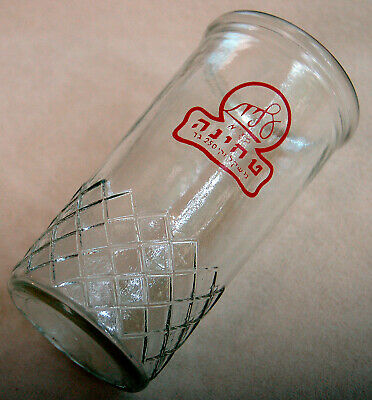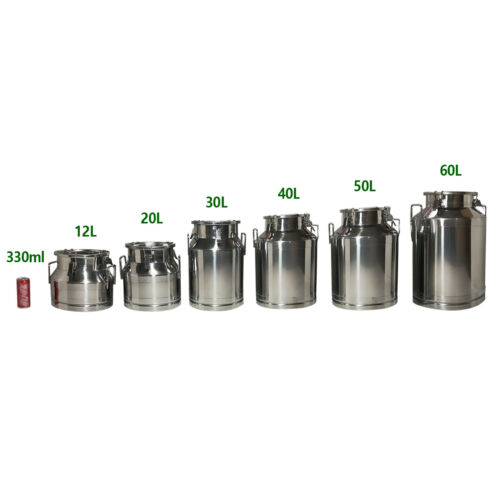-40%
1950 Israel RARE GLASS JAR BOTTLE Jewish KOSHER TAHINI Hebrew ELITE Tahina FOOD
$ 34.32
- Description
- Size Guide
Description
DESCRIPOTION:
Up for auction is handsome GLASS JAR - BOTTLE which was manufactured and used in The 1950's up to the 1960's in by one of the Israeli FIRST and biggest manufacturers of COFFEE , CHOCOLATE , SWEETS and TAHINI ( Thina ) "ELITE -
עלית
". The GLASS JAR carries the EMBOSSED red "ELITE" LOGO as well as the Hebrew text " ELITE LTD" and “TAHINI” . Nicely designed with checkered design. Measures around
5" x 2.5" .
It's in a VERY GOOD condition. Intact. No chips or other imperfections. ( Pls look at scan for accurate AS IS images ) .The JAR - BOTTLE will be sent in a special protective rigid sealed packaging.
PAYMENT
:
P
ayment method accepted : Paypal .
SHIPPMENT
:
Shipp worldwide via registered airmail is
$ 25
. Will be shipped inside a highly protective packaging.
Will be sent around 5 days after payment .
Tahini /tɑːˈhiːni/ (also tahina /tɑːˈhiːnə/; Arabic: طحينة) is an oily paste made from toasted ground hulled sesame seeds used in North African, Armenian, Greek, Israeli, Cypriot, Iranian, Turkish, Iraqi, and Levantine cuisines. Tahini is served as a dip on its own or as a major component of hummus, baba ghanoush, and halva. Contents 1 Etymology2 History3 Preparation and storage4 Culinary uses5 Nutritional information6 See also7 References Etymology Tahini is a loanword from Arabic: طحينة [tˤaħiːna], or more accurately ṭaḥīniyya طحينية, is derived from the root ط ح ن Ṭ-Ḥ-N which as a verb طحن ṭaḥana means "to grind",[1] the same root as طحين [tˤaħiːn], "flour" in some dialects. The standard Arabic spelling طحينة is transliterated properly as ṭaḥīnah. The last syllable is pronounced [næ, na, nɑ, ne, nɐ], depending on the region where the speaker is from. In Levantine Arabic dialects, however, the last syllable is generally pronounced [ne]. Since most 19th and early 20th century Middle Eastern immigrants to English-speaking countries were Christians from Syria, Lebanon, and Palestine, this might be the origin of the English usage of the final /i/. The source language could also be Greek since tahini in Greek is called precisely ταχίνι (tahini). The word "tahini" appears in English by the late 1930s.[2][3] Plain, unprocessed sesame paste with no added ingredients is sometimes known as "raw tahini".[4] History The oldest mention of sesame is in a cuneiform document written 4,000 years ago that describes the custom of serving the gods sesame wine. The historian Herodotus writes about the cultivation of sesame 3,500 years ago in the region of the Tigris and Euphrates rivers in Ancient Iraq. It was mainly used as a source of oil.[5] Tahini is mentioned as an ingredient of hummus kasa, a recipe transcribed in an anonymous 13th-century Arabic cookbook, Kitab Wasf al-Atima al-Mutada.[6] Sesame paste is an ingredient in some Chinese, Korean, and Japanese dishes; it is used in some versions of the Szechuan dish Dan dan noodles. Sesame paste is also used in Indian cuisine.[7] In the United States, sesame tahini, along with other raw nut butters, was available by 1940 in health food stores.[2] Preparation and storage Tahini is made from sesame seeds that are soaked in water and then crushed to separate the bran from the kernels. The crushed seeds are soaked in salt water, causing the bran to sink. The floating kernels are skimmed off the surface, toasted, and ground to produce an oily paste.[8] Because of tahini's high oil content, many manufacturers recommend refrigeration to prevent spoilage. This is particularly true among makers of raw, organic tahini, who will often prepare their tahini at low temperatures and ship and store it in refrigerated cases to maximize quality and shelf life.[9] Culinary uses Hummus and ful topped with tahini Tahini-based sauces are common in Middle Eastern restaurants as a side dish or as a garnish, usually including lemon juice, salt and garlic, and thinned with water, as Hummus made of cooked, mashed chickpeas blended with tahini, olive oil, lemon juice, salt and garlic. Tahini sauce is also a popular topping for meat and vegetables in Middle Eastern cuisine. In Armenia, tahini can be used as a sauce to put in the lahmajoun. In Turkey, tahini (Turkish: tahin) is mixed with pekmez to form a dish called tahin-pekmez. Due to its high-caloric nature, it is served as a breakfast item or after meals as a dessert to dip pieces of bread in, especially during the wintertime. In Iraq, tahini is known as "rashi" and is mixed with date syrup (rub) to make a sweet dessert usually eaten with bread. Tahini is called ardeh (ارده) in Persian and harda in Kuwait. In Iran it is used to make halvardeh (حلواارده), a kind of halva. In Cyprus, tahini, locally known as tashi, is used as a dip for bread and in pitta souvlaki rather than tzatziki, which is customary in Greece. In Greece, tahini (Greek: ταχίνι) is used as a spread on bread either alone or topped with honey or jam. Jars of tahini ready-mixed with honey or cocoa are available in the breakfast food aisles of Greek supermarkets. In Israel, tahini (Hebrew: טחינה, t'hina) is a staple foodstuff. It is served as a dip with flat bread or pita, a topping for falafel, sabich, Jerusalem mixed grill and shwarma, and as an ingredient in various spreads. It is also used as a cooking sauce for meat and fish.[10] and in sweet desserts like halva, halva parfait,[11] halva ice cream and tahini cookies. It is also served baked in the oven with kufta made of lamb or beef with spices and herbs, or with a whole fish in the coastal areas and the Sea of Galilee. In the Gaza Strip, a rust colored variety known as "red tahina" is served in addition to ordinary tahina. It is achieved by a different and lengthier process of roasting the sesame seeds, and has a more intense taste. Red tahina is used in sumagiyya (lamb with chard and sumac) and salads native to the falaheen from the surrounding villages, as well as southern Gaza. In the Levant, tahini (Arabic: t'hine) is a staple foodstuff prepared with mashed garlic and lemon juice. It is served as a dip with pita, a topping for falafel and shwarma, and as an ingredient in various spreads. It is also used as a cooking sauce for meat and always served as a side with fish. It is also a main ingredient in a seafood dish called Siyadiyeh. Tahini is in sweet desserts like halva and halva with pistachios. In East Asia, sesame paste (Chinese: 芝麻醬) is a major condiment used in dry noodles (hot or cold). Sesame paste can also be eaten as a snack, known as 芝麻糊. Nutritional information [show]Tahini nutrition facts Tahini is an excellent source of copper, manganese and the amino acid methionine.[12] Tahini is a source of the healthy fatty acids omega-3 and omega-6.[13] Tahini in a jar with natural oil separation visible at the top Tahini made from raw sesame seeds is lower in fat than tahini made from roasted seeds.[14][15] Tahini's relatively high levels of calcium and protein make it a useful addition to vegetarian and vegan diets, as well as to raw food diets when eaten in its unroasted form. Compared to peanut butter, tahini has higher levels of fiber and calcium and lower levels of sugar and saturated fats.[16] Tahini is an important ingredient in Middle Eastern cuisine and several other ethnic cuisines, including Greek, North African, and Turkish cuisine. It's a central ingredient in recipes such as hummus, as well as many vegan salad dressings, such as goddess dressing. Many Middle Easter restaurants serve tahini alongside falafel, or, if you order a combination appetizer or vegetarian platter, it'll likely be one of the saucey dips that come along side your falafel, pita, and hummus. Israeli cuisine (Hebrew: המטבח הישראלי ha-mitbach ha-yisra’eli) comprises local dishes by people native to Israel and dishes brought to Israel by Jews from the Diaspora. Since before the establishment of the State of Israel in 1948, and particularly since the late 1970s, an Israeli Jewish fusion cuisine has developed.Israeli cuisine has adopted, and continues to adapt, elements of various styles of Jewish cuisine and regional Arab cuisine, particularly the Mizrahi, Sephardic and Ashkenazi styles of cooking. It incorporates many foods traditionally eaten in Middle Eastern and Mediterranean cuisines, and foods such as falafel, hummus, shakshouka, couscous, and za'atar are now thought to be synonymous with Israeli cuisine.Other influences on cuisine are the availability of foods common to the Mediterranean region, especially certain kinds of fruits and vegetables, dairy products and fish; the distinctive traditional dishes prepared at holiday times; the tradition of keeping kosher; and food customs specific to Shabbat and different Jewish holidays, such as challah, jachnun, malawach, gefilte fish, cholent (hamin) and sufganiyot. New dishes based on agricultural products such as oranges, avocados, dairy products and fish, and others based on world trends have been introduced over the years, and chefs trained abroad have brought in elements of other international cuisines. Kosher foods are those that conform to the regulations of kashrut (Jewish dietary law). Food that may be consumed according to halakha (Jewish law) is termed kosher in English, from the Ashkenazi pronunciation of the Hebrew term kashér, meaning "fit" (in this context, fit for consumption). Food that is not in accordance with Jewish law is called treif (Yiddish: טרײף or treyf, derived from Hebrew A list of some kosher foods are found in the books of Leviticus 11:1-47 and Deuteronomy 14: 3-20, as are also certain kosher rules. Reasons for food not being kosher include the presence of ingredients derived from nonkosher animals or from kosher animals that were not slaughtered in the ritually proper manner, a mixture of meat and milk, wine, or grape juice (or their derivatives) produced without supervision, the use of produce from Israel that has not been tithed, or the use of non-kosher cooking utensils and machinery. ebay3239














